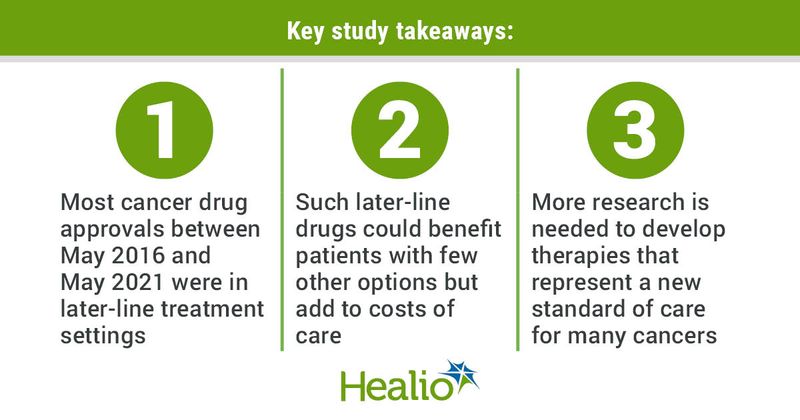Only 14% of new cancer drug approvals displace existing standards of care
Most cancer drug approvals between 2016 and 2021 applied to second-, third- or later-line treatment settings and did not displace current standard-of-care therapies, according to a study published in JAMA Network Open.
Researchers of the retrospective, cross-sectional study concluded that although newer drugs may benefit patients with few alternatives, they could also add to the cost of care, with competition in drug markets vital to reducing prices.

“The fields of oncology and hematology have seen many cancer drug approvals over the past several years. However, it was unclear to our research team how many of these drug approvals displace the standard-of-care therapy (first-line treatment option) at the time of their approval and ultimately represent the new standard-of-care for a particular cancer vs. approval as a second- or third-line treatment option,” David J. Benjamin, MD, chief fellow in the division of hematology and oncology in the department of medicine at University of California, Irvine, told Healio.
Methodology
The analysis included 207 FDA cancer drug approvals between May 1, 2016, and May 31, 2021.
Benjamin and colleagues evaluated the approvals via the FDA Oncology/Hematologic Malignancies Approval Notifications website and examined all clinical trials that led to approval of cancer drugs. They evaluated the comparator arm (when applicable) and reviewed National Comprehensive Cancer Network guidelines to determine if the drug had displaced the prior standard-of-care therapy. They separated drug approvals into the following categories:
first-line displacing — approved for use in the first-line setting and displaced the prior standard-of-care drug for an indication;
first-line drug alternatives/new — approved for use in the first-line setting but did not displace the standard of care at the time of approval or was first of its class for an approved indication;
add on — approved in combination with a previously approved therapy for a disease or for use in the adjuvant or maintenance settings; and
later line — approved for use in the second- or third-line settings or later.
Key findings
Among the 207 approvals, researchers identified 28 drugs (14%) as first-line displacing therapies, 32 (15%) as first-line drug alternatives/new drugs, 61 (29%) as add-on therapies and 86 (42%) as later-line therapies.
Implications
Benjamin and colleagues wrote that although the high volume of new cancer drugs is cause for excitement, the approvals must be evaluated in context of their use.
“I believe our study underscores that although there is justified enthusiasm for new cancer drug options for patients with limited treatment options if they don't respond to the first-line treatment option, there is still a need for more research to be done to develop new therapies that represent a new standard-of-care (first-line option) for treating many cancers,” Benjamin said.
For more information:
David J. Benjamin, MD, can be reached at Division of Hematology and Oncology, Department of Medicine, University of California, Irvine, 101 The City Drive South, Orange, CA 92868; email: djbenjam@hs.uci.edu.

